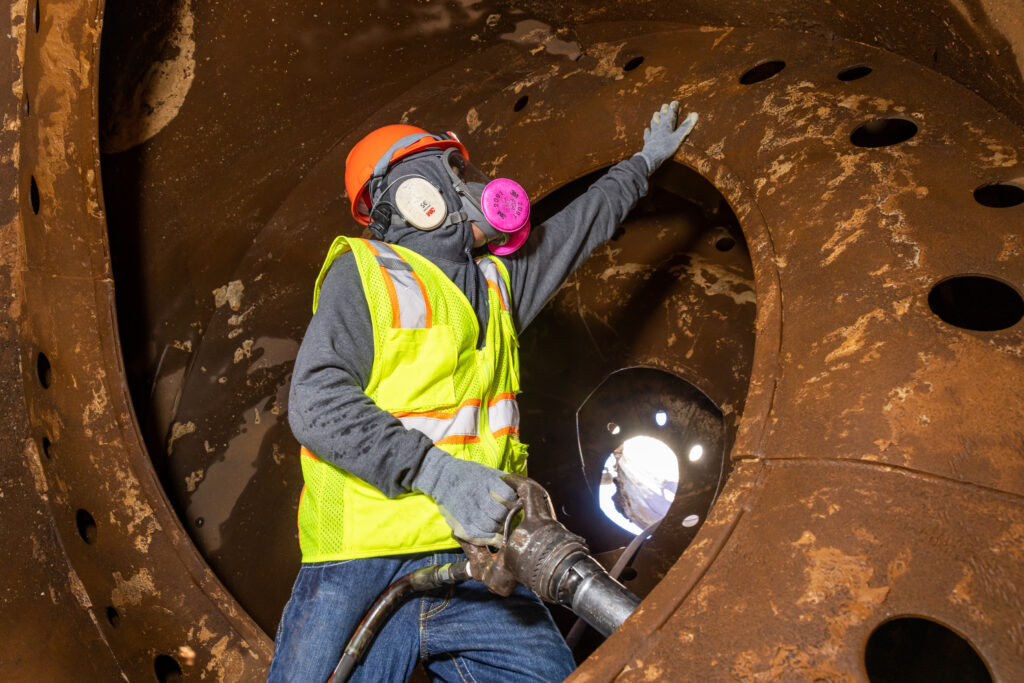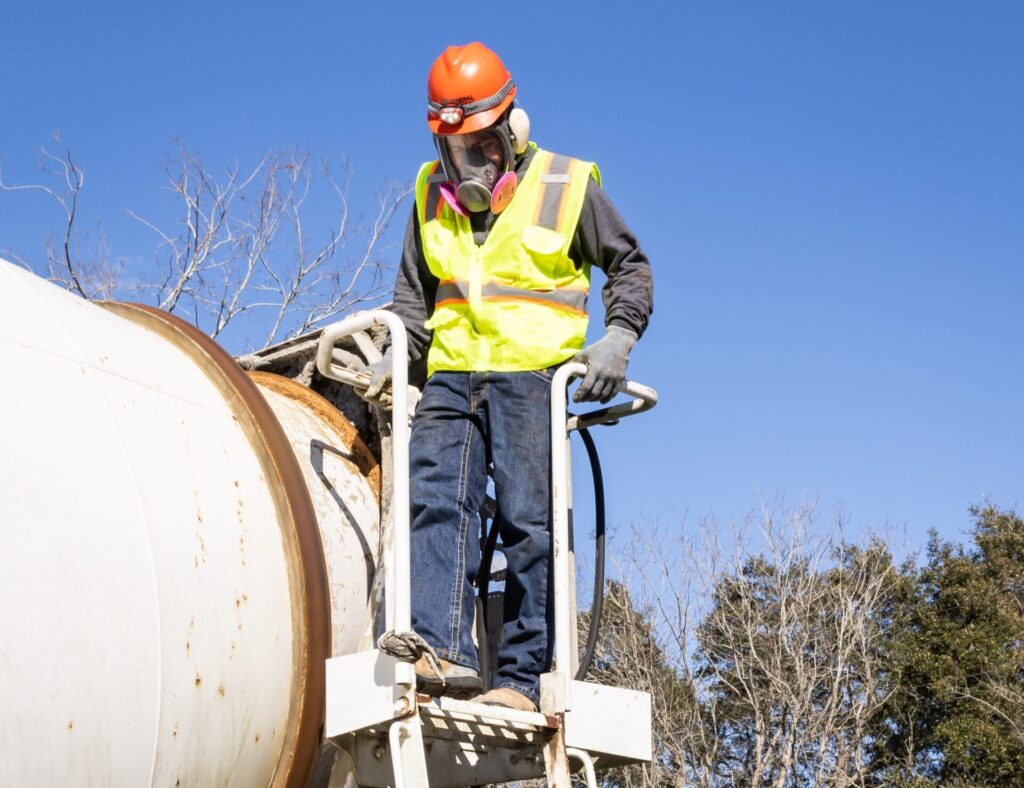
A Day in the Life of a Concrete Chipper
Concrete chipping is an incredibly niche industry — one with only a handful of companies dedicated solely to the work. That exclusivity can create an air of mystery, but more often than not it results in confusion about what a crew like ours does, why the work is necessary and what an average day looks like. The General Chipping team hopes to provide clarity about what it means to be a concrete chipper.
Our concrete chipping pros have pulled together an in-depth look at the support we provide concrete and construction crews, how we go about the work and special considerations that come into play on the job. Read on for an enlightening look at our day-to-day and insights into how we keep construction companies’ valuable tools and vehicles ready to roll.
What Does a Concrete Chipper Do?
Concrete chipping companies look after the ready mix concrete trucks, cement silos and central mixers construction companies rely on to create concrete and haul it to the job site. There are three basic aspects of the work:
- Concrete Chipping: Using handheld jackhammers, crews enter ready-mix truck drums to remove hardened material that has dried along the walls. This improves carrying capacity and helps ward off mechanical issues which can lead to costly slowdowns, repairs and replacements.
- Silo Cleaning: Concrete chippers are lowered into cement storage silos to remove clumps and clogs that slow the cement’s release — and can throw project schedules off track. Those clogs are ushered out the bottom of the silo.
- Central Mixer Cleaning: Crew members reach inside central mixers to remove hardened material from the drums’ walls. This results in a healthier mixer capable of holding more material than before.
What Does a Concrete Chipper’s Daily Schedule Look Like?
The average concrete chipper operates on a very different schedule than most other people do, due in large part to when the main thrust of their work takes place. Here’s a look at what a typical day looks like for a member of our crew.
NOTE: Because every person — and concrete chipping job — is different, there will always be some variation. This is meant to serve as an overall guideline.
Noon (or Later): Up and at ‘Em
Overnight shifts mean late nights for concrete chippers, so they get a later start than many professionals. Around this time, they’re waking up, eating lunch, tending to errands and preparing for the day’s work.
3 p.m.: Hitting the Road
Although we work hard to map jobs out in a way that makes sense, we carry out work nationwide. That means our concrete chippers spend plenty of time behind the wheel. At this point, they’re mapping their route, heading out and, if possible, checking into their lodgings.
6 p.m.: Getting Down to Business
Before beginning their work, team members warm up their muscles to ward off strains, sprains and injury. After that, they get into their PPE, grab their handheld jackhammers and other equipment, and get chipping.
9 p.m.: Dinner Time
Everybody’s got to eat — even concrete chippers. Around this time, the crew breaks to fuel up for the remainder of their 12-hour shift with a meal.
6 a.m.: Time to Pack Up
Crew members gather their tools, load their vehicles and grab something to eat before getting some well-deserved rest. The process starts over again the next day!

What Health & Safety Concerns Are Associated with Chipping Concrete?
All concrete and construction work carries risks, and concrete chipping is no exception. Our work requires crew members to physically enter ready mix concrete truck drums or reach inside central mixers when chipping concrete. Similarly, for cement silo cleaning, we physically lower team members into silos. Let’s look at some of the main health and safety concerns that come into play during concrete chipping appointments.
- Cement & Silica Dust Exposure: Respirable silica dust, or cement dust, poses risks to construction workers when it becomes airborne while emptying bagged cement into mixers. In our line of work, the danger comes when the act of chipping concrete releases dust. When inhaled, that dust can result in lung disease and long-term respiratory issues. Exposure to the skin and eyes can also result in irritation, chemical burns or even blindness.
NOTE: Adequate ventilation is crucial to ensure safe work around cement dust, as is proper personal protective equipment (PPE) in the form of respirators, eye protection, gloves and clothing with proper coverage.
- Noise Hazards: The handheld jackhammers used to chip dried concrete from the walls of your ready mix truck and central mixer — and to free clumped cement inside silos, too — can be deafening. (And that’s no exaggeration.) Concrete chippers work in small metal spaces that amplify sound and result in eventual hearing loss.
NOTE: Properly fitting hearing protection rated for the noise levels to which a concrete chipper is exposed is important when looking out for their auditory health. Foam or pre-molded earplugs that fit into the ear canal are common options, as are protective earmuffs that fit over the ear. - Vibration Injuries: Concrete chippers’ handheld jackhammers are pneumatic, often exposing workers’ bodies to extreme vibration for hours on end. Improper use can lead to issues such as Hand-Arm Vibration Syndrome (HAVS), a condition which causes discoloration, numbness, pain, tingling and weakness in the hands and fingers. Musculoskeletal disorders (MSDs) such as neck and back pain or joint issues are also common.
NOTE: Use of vibration-dampening work gloves and regular breaks from strenuous chipping work play an essential role in preventing lifelong injuries. - Confined Space Risks: As we’ve mentioned, concrete chipping and silo cleaning require team members to work inside incredibly cramped environments. A concrete chipper often faces risks such as reduced air quality and lower ventilation, limited mobility and the potential of being struck by flying debris. A risk unique to work inside silos is the potential for a team member standing on top of dried material to fall into the cement, facing risk of suffocation.
NOTE: Specialized training paired with proper PPE is crucial in allowing a concrete chipper to safely navigate cramped workspaces. Regular communication with vigilant team members or spotters outside the confined space can also save lives. - Fall Risks: Although most of a concrete chipper’s work takes place inside a concrete truck drum or cement silo, accessing these areas leaves workers open to the potential for serious slips and falls. A fall from the ladders used to enter a ready mix truck drum or silo can result in sprains, strains, bone breaks and lifelong health concerns. Falls into the dry material housed inside the silo can result in the aforementioned suffocation risks.
NOTE: Adequate training in the proper use of PPE — and reminders at regular intervals — can go a long way toward keeping teams working safely together. Regular inspection of your crew’s PPE, and replacement when necessary, is equally important.
Concrete chipping work is incredibly specialized work, and it plays a critical role in the long-term health of construction companies’ drums, silos and mixers. We hope the above information helped to clear up any questions you might have. If you’d like to learn more, or if you’re interested in learning more about General Chipping’s concrete chipping, central mixer cleaning and silo cleaning offerings, feel free to reach out at any time. Our team is here to help!
